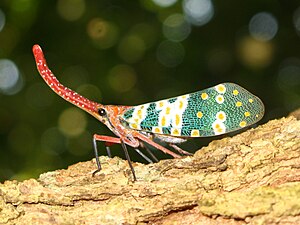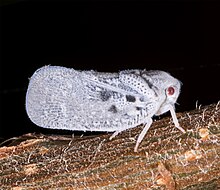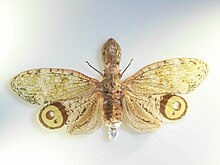Pointed leaf hoppers
| Pointed leaf hoppers | ||||||||||||
|---|---|---|---|---|---|---|---|---|---|---|---|---|

|
||||||||||||
| Systematics | ||||||||||||
|
||||||||||||
| Scientific name | ||||||||||||
| Fulgoromorpha | ||||||||||||
| Evans , 1946 |
The pointed head cicadas (Fulgoromorpha), also called lantern- bearer-like, are a suborder of the Schnabelkerfe (Hemiptera). More than 12,900 species have been described worldwide.
description
Just like the round-headed cicadas (Cicadomorpha), most pointed-head cicadas have excellent jumping ability. The jumping mechanism is based on powerful muscles that are located in the trunk and attack the trochanter of the hind legs. The muscle energy is used to stretch elastically deformable parts of the exoskeleton . When a locking mechanism is released, this energy is then released explosively. In contrast to other jumping insects, whose jumping muscles are in the thighs , they do not have any noticeably enlarged hind legs. In contrast to all other insects , the pinpoint eyes are below the compound eyes , and the antennae also arise there.
The most prominent representatives of this group are the lantern bearers of the genus Fulgora, native to South America, with a conspicuous extension of the forehead, which looks like a peanut from above and like the head of an alligator when viewed from the side . Fulgora laternaria is best known in Europe for the drawings by Maria Sibylla Merian . It was mistakenly assumed that the hollow head extension glowed, hence the name lantern bearer .
Systematics
The family relationships of the groups ( phylogeny ) within the Schnabelkerfe has not yet been conclusively clarified. However, all species that belong to the pointed head cicadas have some common characteristics that identify them as so-called monophylum , that is, they all go back to a common parent species. According to the latest research, the Fulgoromorpha are closer to the bedbugs (Heteroptera) than the round-headed cicadas, which were previously thought to be their sister group . The pointed head cicadas (Fulgoromorpha) and round head cicadas (Cicadomorpha) are currently still predominantly grouped together in the group of cicadas (Auchenorrhyncha). Pointed-head cicadas differ from the round-head cicadas in that they have a chitin scale over the forewing joint and the presence of a "y-vein" in the clavus of the forewing. For more information on the system, see Schnabelkerfe (Hemiptera).
Families of the Fulgoromorpha
Pointed-head cicadas occur on all continents with the exception of Antarctica. Currently, 17 to 21 families of the Fulgoromorpha are known worldwide, all of which belong to the only recent superfamily Fulguroidea. The Coleoscytoidea and the Surijokocixioidea are two other superfamilies whose members are only known from fossils. In Europe there are 737 species in 170 genera from 13 families, of which 9 families with 211 species in 83 genera occur in Central Europe and 7 families with 143 species in 64 genera in Germany. The system of pointed-head cicadas is not yet complete and is still changing.
Systematics with German names of families according to Kunz 2011 and selected species:
- Superfamily: Fulguroidea
Kirkaldy , 1907
- Family: Glass-winged leaf hoppers (Cixiidae Spinola , 1839) (Worldwide including Europe, Central Europe & Germany)
- Subfamily: Borystheninae Emeljanov , 1989 (Africa & Southeast Asia)
- Subfamily: Bothriocerinae Muir , 1923 (North America & South America)
- Subfamily: Cixiinae Spinola , 1839 (Worldwide including Europe, Central Europe & Germany)
- Glory Glasflügelzikade ( Hyalesthes obsoletus Signoret , 1865) (including North Africa, Asia, Europe. Central Europe & Germany)
- Family: Red leaf hoppers (Delphacidae Leach , 1815) (Worldwide including Europe, Central Europe, Germany)
- Subfamily: Asiracinae Motschulsky , 1863 (Synonym Ugyopinae) (North America, South America, Australia, Europe, Central Europe, Germany)
- Subfamily: Delphacinae Leach , 1815 (North America, South America, Australia, Europe, Central Europe, Germany)
- Harlequin Spurred Cicada ( Hyledelphax elegantulus ( Boheman , 1847))
- Subfamily: Kelisiinae Wagner , 1963 (North America, South America, Europe, Central Europe, Germany)
- Subfamily: Plesiodelphacinae ash , 1985 (South America)
- Subfamily: Stenocraninae Wagner , 1963 (North America, South America, Australia, Europe, Central Europe, Germany)
- Striped Spurred Cicada ( Stenocranus minutus ( Fabricius , 1787))
- Subfamily: Vizcayinae ash , 1990 (South America)
- Family: Sparrowhoppers ( Kinnaridae Muir , 1925) (Africa, Asia, North America, South America, Europe)
- Family: Green leafhopper (Caliscelidae Amyot & Serville , 1843) (Worldwide including Europe, Central Europe, Germany)
- Subfamily: Caliscelinae Amyot & Serville , 1843 (Worldwide including Europe, Central Europe)
- Subfamily: Ommatidiotinae fever , 1875 (Asia, Europe, Central Europe, Germany)
- Bog beetle cicada ( Ommatidiotus dissimilis ( Fallén , 1806)) (Asia, Europe, Central Europe, Germany)
- Family: ant cicadas (Tettigometridae Germar , 1821) (Africa, Asia, Europe, Central Europe, Germany)
- Family: False cicadas ( Achilixiidae Muir , 1923) (South America, Southeast Asia)
- Family: Moth cicadas (Derbidae Spinola , 1839) (worldwide including Europe)
- Subfamily: Derbinae Kirkaldy , 1906 (Africa, North America, Australia, Europe)
- Subfamily: Cedusinae Emeljanov , 1992 (North America, Australia)
- Subfamily: Otiocerinae Muir , 1913 (Africa, Asia, North America, Australia)
- Subfamily: Zoraidinae Muir , 1913 (possibly part of the Otiocerinae) (Asia)
- Family: Reticulated leafhoppers ( Acanaloniidae Amyot & Serville , 1843) (Indonesia, southern North America to central South America)
- Subfamily: Acanaloniidae Amyot & Serville , 1843 (southern North America, Indonesia)
- Subfamily: Tonginae Kirkaldy , 1907 (assignment unclear) (Asia, Australia)
- Subfamily: Trienopinae Fennah , 1954
- Family: beetle cicadas (Issidae Spinola , 1839) (worldwide including Europe, Central Europe & Germany)
- Subfamily: Issinae Spinola , 1839 (Australia, Europe, Central Europe, Germany)
- True Beetle Cicada ( Issus coleoptratus ( Fabricius , 1781)) (Europe, Central Europe, Germany)
- Subfamily: Hemisphaeriinae Melichar , 1906 (Asia)
- Subfamily: Bladininae Kirkaldy , 1907 (assignment unclear) (Australia)
- Subfamily: Issinae Spinola , 1839 (Australia, Europe, Central Europe, Germany)
- Family: Lophopidae Stål , 1866 (Africa, Asia, Central America, South America, Australia)
- Subfamily: Lophopinae Stål , 1866
- Subfamily: Menoscinae Melichar , 1915
- Family: Eurybrachidae Stål , 1866 (Africa, Southeast Asia, Australia)
- Subfamily: Platybrachinae Metcalf , 1952 (Australia)
- Family: Gengidae Fennah , 1949 (status unclear) (South Africa)
- Family: Butterfly cicadas (Flatidae Spinola , 1839) (Worldwide including Europe, Central Europe)
- Subfamily: Flatinae Melichar , 1901 (North America, Africa, Asia, Australia, Europe, Central Europe)
- Bluebird ( Metcalfa pruinosa ( Say , 1830)) (North America, Europe, Central Europe)
- Phromnia rosea ( Melichar , 1901) (Madagascar)
- Subfamily: Flatoidinae Melichar , 1910 (North America, Australia)
- Subfamily: Flatinae Melichar , 1901 (North America, Africa, Asia, Australia, Europe, Central Europe)
- Family: Hypochthonellidae China & Fennah , 1952 (status unclear) (Africa)
- Family: Broad-winged leaf hoppers (Ricaniidae Amyot & Serville , 1843) (worldwide including Europe)
- Family: Real bark cicadas (Achilidae Stål , 1866) (North America, Australia, Europe, Central Europe, Germany)
- Subfamily: Achilinae Stål , 1866 (Australia, Europe, Central Europe, Germany)
- Genus Synecdoche O'Brien , 1971 (North America, South America)
- Subfamily: Achilinae Stål , 1866 (Australia, Europe, Central Europe, Germany)
- Family: Bush cicadas ( Nogodinidae Melichar , 1898) (Africa, Asia, Australia, North America, South America)
- Subfamily: Gastriniinae Fennah , 1987 (South America)
- Subfamily: Nogodininae Melichar , 1898 (Africa, Asia, Australia, North America, South America)
- Family: Mosquito cicadas (Tropiduchidae Stål , 1866) (Worldwide including Europe, Central Europe)
- Subfamily: Elicinae Melichar , 1815
- Subfamily: Tropiduchinae Kirkaldy , 1907 (Australia, Europe, Central Europe)
- Subfamily: Tambiniinae Kirkaldy , 1907 (Australia, North America)
- Family: Grasshopper (Meenoplidae Fever , 1872) (Africa, Asia, South America, Australia, Europe)
- Subfamily: Kermesiinae Kirkaldy , 1906 (synonym Nisiinae) (Australia, Europe)
- Subfamily: Meenoplinae fever , 1872 (Europe)
- Family: Real lantern bearers ( Fulgoridae Latreille , 1807) (Africa, Asia, Australia, North America, South America)
- Subfamily: Amyclinae Metcalf , 1938 (North America, Australia)
- Subfamily: Aphaeninae Blanchard , 1847 (Australia)
- Subfamily: Aluntiinae Emeljanov , 1979 (Madagascar, Asia)
- Subfamily: Capeninae Emeljanov , 1979 (Africa)
- Subfamily: Enchophorinae Haupt , 1929
- Subfamily: Dichopterinae Melichar , 1912 (Asia)
- Subfamily: Dorysarthrinae Emeljanov , 1979 (North Africa, Asia)
- Subfamily: Fulgorinae Spinola , 1839
- Fulgora laternaria ( Linnaeus , 1758) (South America)
- Pyrops candelaria ( Linnaeus , 1758) (Asia)
- Subfamily: Lyncidinae Schmidt , 1915 (Africa)
- Subfamily: Phenacinae Haupt , 1929
- Subfamily: Poiocerinae Haupt , 1929 (North America, Australia)
- Subfamily: Strongylodematinae Emeljanov , 1979 (Africa)
- Subfamily: Xosopharinae Lallemand , 1959
- Subfamily: Zanninae Lallemand , 1963 (possibly own family)
- Family: False lantern bearers ( Dictyopharidae Spinola , 1839) (Worldwide including Europe, Central Europe & Germany)
- Subfamily: Dictyopharinae Spinola , 1839 (Worldwide including Europe, Central Europe & Germany)
- European lantern bearer ( Dictyophara europaea ( Linnaeus , 1767)) (North Africa, Asia, Europe, Central Europe, Germany) (only species of this family in Germany)
- Subfamily: Orgeriinae Fever , 1872 (Africa, North America, Asia, Australia, Europe)
- Subfamily: Dictyopharinae Spinola , 1839 (Worldwide including Europe, Central Europe & Germany)
- Family: Glass-winged leaf hoppers (Cixiidae Spinola , 1839) (Worldwide including Europe, Central Europe & Germany)
Individual evidence
- ↑ FLOW (Fulgoromorpha Lists on The Web): a world knowledge base dedicated to Fulgoromorpha. Bourgoin, Th., Accessed March 2, 2015 .
- ↑ Malcolm Burrows (2009): Jumping performance of planthoppers (Hemiptera, Issidae). Journal of Experimental Biology 212: 2844-2855. doi: 10.1242 / jeb.032326
- ^ N. Song, AP. Liang: A Preliminary Molecular Phylogeny of Planthoppers (Hemiptera: Fulgoroidea) Based on Nuclear and Mitochondrial DNA Sequences. In: PLoS ONE . tape 8 , no. 3 , 2013, p. e58400 , doi : 10.1371 / journal.pone.0058400 .
- ↑ Fulgoromorpha in Fauna Europaea , as of March 2, 2015.
- ↑ WE Holzinger et al. (1997): Preliminary list of cicadas from Central Europe (Insecta: Auchenorrhyncha). Contributions to cicada lore 1: 43-62. ( PDF, 122 kB ), accessed on August 31, 2016
- ↑ Herbert Nickel and Reinhard Remane: List of species of cicadas in Germany, with information on nutrient plants, food breadth, life cycle, area and endangerment (Hemiptera, Fulgoromorpha et Cicadomorpha). Contributions to the cicada, 5, 2002, pp. 27–64 full text (PDF, German; 234 kB)
- ↑ Gernot Kunz: Cicadas - the insects of the 21st century? (Hemiptera, Auchenorrhyncha). Entomologica Austriaca, Volume 18, 2011, pp. 105-123.
Literature and Sources
- M.-C. Larivière, MJ Fletcher, A. Larochelle: 2010: Auchenorrhyncha (Insecta: Hemiptera): catalog. Fauna of New Zealand , ( 63 )
- SW Wilson: 2005: Keys to the families of Fulgoromorpha with emphasis on planthoppers of potential economic importance in the southeastern United States (Hemiptera: Auchenorrhyncha). Florida entomologist , 88 : 464-481. PDF
- J. Swzedo, T. Bourgoin, F. Lefèbvre: 2004: An annotated catalog of Fulgoromorpha,: 37-137. In: Fossil Planthoppers (Hemiptera: Fulgoromorpha) of the world. An annotated catalog with notes on Hemiptera classification. Swzedo. J., Th. Bourgoin & F. Lefebvre. J. Swzedo edt., Warsaw 2004, 199 pp + 8 pl.
- T. Bourgoin: 1996-2014. FLOW (Fulgoromorpha Lists on The Web): a world knowledge base dedicated to Fulgoromorpha. http://www.hemiptera-databases.org/flow/
- R. Biedermann, R. Niedringhaus: The cicadas of Germany - identification tables for all kinds . Fründ, Scheeßel 2004, ISBN 3-00-012806-9 .
- WE Holzinger, I. Kammerlander, H. Nickel: The Auchenorrhyncha of Central Europe - Die Zikaden Mitteleuropas. Volume 1: Fulgoromorpha, Cicadomorpha excl. Cicadellidae. - Brill, Leiden 2003, ISBN 90-04-12895-6 .
- H. Nickel: The leafhoppers and planthoppers of Germany (Hemiptera, Auchenorrhyncha): Patterns and strategies in a highly diverse group of phytophagous insects. Pensoft, Sofia and Moscow 2003, ISBN 954-642-169-3 .
- H. Nickel, R. Remane: List of species of cicadas in Germany, with information on nutrient plants, food breadth, life cycle, area and endangerment (Hemiptera, Fulgoromorpha et Cicadomorpha). - Contributions to the cicada 5/2002. PDF, 229 kB
- R. Remane, E. Wachmann : Cicadas - get to know, observe - Naturbuch Verlag, Augsburg 1993, ISBN 3-89440-044-7 .
- Metamorphosis insectorum Surinamensium . Piron, London 1980–1982 (reprint of the Amsterdam 1705 edition)









